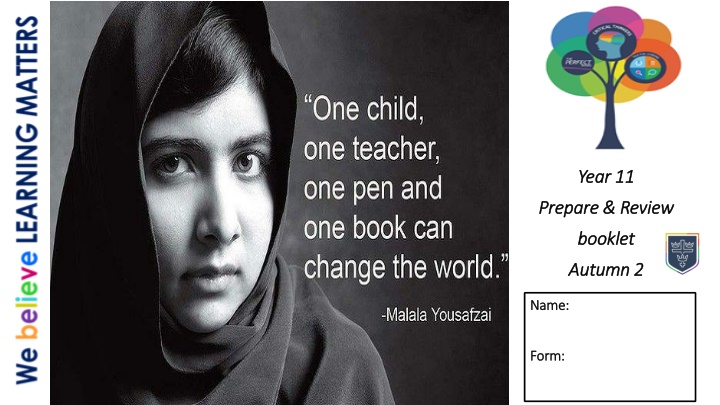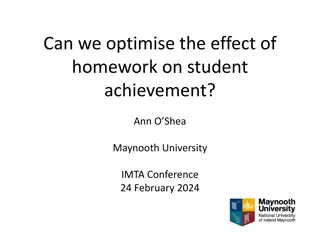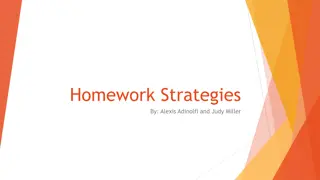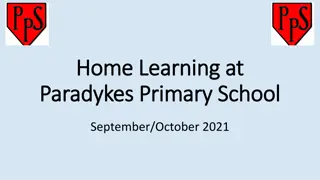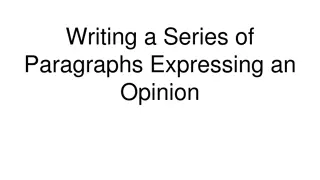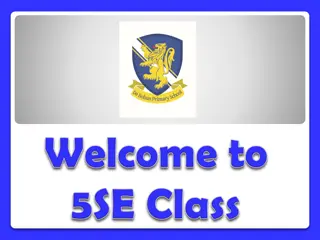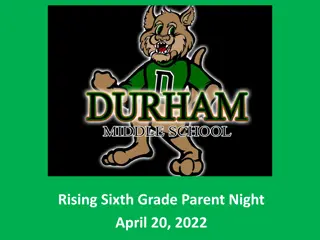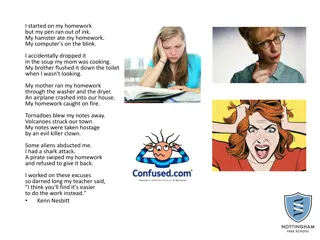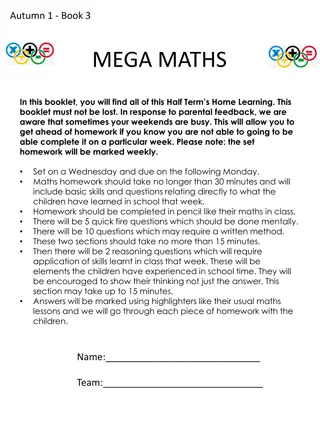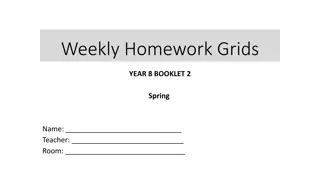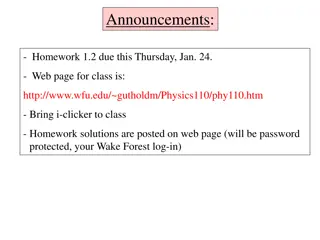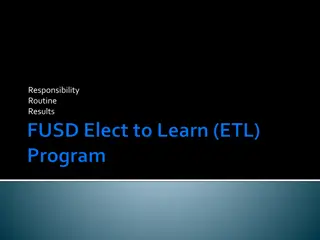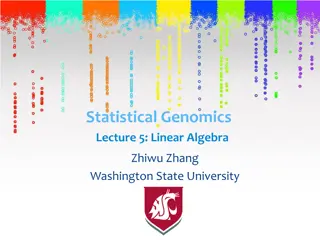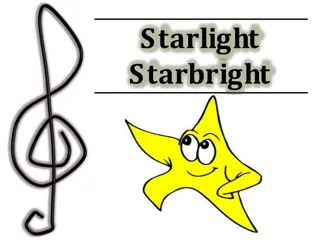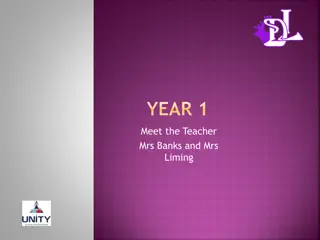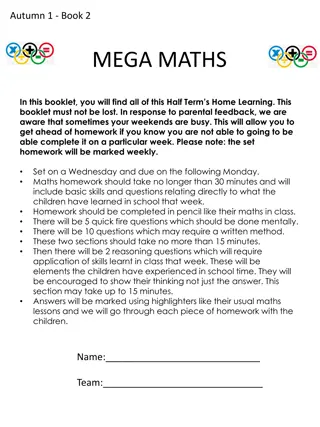BAA School Homework and Learning Guide
Prepare and Review booklet for Autumn Term 2 at BAA School emphasizes the importance of self-belief, inclusion, and critical thinking. The booklet outlines various subjects, homework tasks, and strategies such as Prepare and Review mats and Talk for Learning prompts to enhance students' learning experience. It also introduces revision techniques and coursework expectations for Year 10 students and above.
Download Presentation

Please find below an Image/Link to download the presentation.
The content on the website is provided AS IS for your information and personal use only. It may not be sold, licensed, or shared on other websites without obtaining consent from the author.If you encounter any issues during the download, it is possible that the publisher has removed the file from their server.
You are allowed to download the files provided on this website for personal or commercial use, subject to the condition that they are used lawfully. All files are the property of their respective owners.
The content on the website is provided AS IS for your information and personal use only. It may not be sold, licensed, or shared on other websites without obtaining consent from the author.
E N D
Presentation Transcript
Year Year 11 11 Prepare & Review Prepare & Review booklet booklet Autumn 2 Autumn 2 Name: Name: Form: Form:
Through believing in ourselves, in others, in God, we aspire to be courageously inclusive At the root of our learning is our school ethos and values. From this, our learners grow and are guided to become highly literate, CRITICAL thinkers through Talk for learning, the PERFECT model and a knowledge rich curriculum. Contents Contents Homework at BAA English Food Science Geography History Music Product design Physics PE RS Spanish Textiles Business Studies How to revise Timetable for homework Reading at BAA Talk For Learning How to use prepare and review mats Art Biology Chemistry Computer Science Drama
Homework at BAA Prepare and review mats Our Prepare and Review mats form the basis of pupil s homework tasks. Prepare activities (also known as flipped learning)- This allows pupils to come to lesson knowing something they have not learnt yet, but prepares them for the lesson. Pupils will then build on this learning in their lesson. Review (Retrieval and revision)- This homework allows pupils to retrieve learning from previous weeks, months or years. All pupils will receive retrieval every lesson based on current and previous learning, during a topic a rolling recall quiz to check understanding of the current topic and online quizzes that allow pupils to tests their understanding at the end of a topic. Revision: Pupils will be told that they have an assessment and will be able to use revision techniques from our clock and will know what content to cover during revision. Please see the back of the booklet for the revision techniques and links to the revision website. Additional homework may be set by teachers as needed Year 10 and upwards Coursework: As pupils move into Year 10 and onwards, they could be set coursework as homework.
Talk for learning During any class task or homework task pupils should be using the prompts below to help them prepare to learn, during learning planning and monitoring prompts and after a learning task reflection prompts. Prepare (Pre-lesson or at the start of a lesson or during homework): What learning can I do to prepare me for my lesson/exam/test? (Flipped/revision) What knowledge or skills am I missing? How can I gain this knowledge or skill? (Revision website, websites recommended by my teachers). How does this feed into my revision/learning plan? Plan (At the start of a task in lesson/test/exam or a homework task): Have I done this before? What skills do I need to complete this task? What is the question asking me? What key words are needed? What equation? What structure do I need? What knowledge do I need? Monitor (During a task in lesson/test/exam or during a homework task): How is it going? Do I need to change what I am doing? Re-check the question/task, Is the vocabulary/equation/structure correct for the question? Does the knowledge link back to the question? Reflect (At the end of a task in lesson/assessment/ exam/homework task): How did it go? Did I need to do it differently? What went wrong? Why? Had I read the question wrong? Not revised in the right way? Or enough/ right material? Did I need to prepare better? Exam/assessment wrappers will help you do reflect
How to use prepare and review mats 4)Knowledge and skills: This is where pupils and parents access the knowledge for the topic e.g BBC bite size, revision guide pages. These can be used for review activities below. This also indicates the skills they will learn during the topic. Sequence of learning pupils will find the sequence of learning for the topic that half term (these are the same as the curriculum maps on the website). 3) Tier 2 and 3 key vocabularyand definitions. These are the keywords that will be important in this topic. Some may be blank so that definitions can be added. 5) Prepare activities These are activities that pupils will use in lesson to enhance their learning, these will also go onto Go4Schools for pupils so they are aware of the date they are needed. Links to prior and learning that pupils can see how the whole course links together. future so Revision clock: This row is set out following our revision clock (see pg 8-9 in this booklet or go to our revision website 8) Reading for pleasure, these are books related to this topic and that staff recommend reading. All the books are in our school library. Pupils also have access to reading cloud . 6) Revision clock (Review) These activities are allow pupils to practice review techniques. One of these will be a graphic organiser that staff will help them build and one other per topic e.g flashcards, condense and explode 7) Revision clock (Practice and check) After review activities then pupils should practice and check just like the clock..
Prepare and Review: Biology Autumn Sequence of learning Photosynthesis Tier 2 Vocabulary Definition Tier 3 Vocabulary Definition Where to find key knowledge for the topic and skills needed? Classification systems Changing classification over time Communities and competition Biotic and abiotic factors Adaptations Levels of organisations 1 Trophic levels (triple) Levels of organisation 2 PAG 9 PAG recap (calculations) A sample a small part of anything or one of a number, intended to show the quality, style, or nature of the whole; specimen Ecosystem BBC Bitesize classification and ecosystems Classify To arrange or organize by classes Community An interacting group of varying species in a common location. Interpreting to give or provide the meaning of Biotic/abiotic This links to previous learning Genetics and reproduction i.e DNA structure Interactions Influence between objects Quadrat Career link Horticulturist, farmer, botanist, research scientist, ecologist Distribution Place where any item occurs Trophic level This links to future learning biodiversity, evolution, speciation Estimate to form an approximate judgment or opinion regarding the worth, amount, size, weight, etc. Habitat The natural home or environment of an animal, plant or other organism. abundance an extremely plentiful or over sufficient quantity or supply Adaptation Something to read Prepare activities Define the tier three words that are missing definitions Complete the classification task overleaf Complete the adaptations task overleaf. organiser David Attenborough A life on our planet Due date: See GoForSchools Due Date: See GoForSchools Due Date: See GoForSchools How can I review my learning? How can I practice and check? Use your graphic organiser you build in lesson to look cover and check. Each week bring 3 flash cards with a key word on one side and the definition on the other or key question with the answer on the other. Add an image to the card. These will be used in retrieval in lesson. Retrieval quiz set by your teacher Use the BBC Bitesize page and try the quizzes Footprints quiz Use Seneca Due date
Knowledge organiser Classification Adaptations Write down all the physical adaptations a polar bear and a camel have, in order to survive in their habitats Fill in each level of the taxonomic classification systems Competition Biotic and abiotic Questions 1. What is interspecific competition? 2. What is intra specific competition? 3. State all the resources animals compete for 4. State all the resources plants compete for 5. State what a keystone species is and explain how they increase biodiversity State the name for the different biotic and abiotic factors above
Prepare and Review: Health and the People Medicine Stands Still Sequence of learning Autumn 1 Medicine Stands Still Tier 2 Vocabulary Definition Tier 3 Vocabulary Definition: Fill in the definitions of these key terms when your teacher tells you to. Where to find key knowledge for the topic and skills needed? Where did Medieval ideas about health come from? Who would treat the sick in Medieval times? How did Islam affect medieval medicine? How did Christianity affect medieval medicine? Where was public health worse in the Medieval period? Where was public health worse in the Medieval period? Medieval Hospitals How good was medieval surgery? Consequences of poor public health. Describe Summarise what you have read/seen using factual knowledge. Hippocratic Oath Health and the People (ncl.ac.uk) Define Write out what a word means Barber Surgeon Evaluate Think about the different points of view on a topic or piece of information. Discuss both sides of the argument Humours This links to previous learning Building upon learning from History GCSE Paper 1: Conflict and Tension 1894-1918 Germany: 1890-1945 Explain Use facts to write the causes, effects and changes of a historical event. Public Health Careers link: A history degree is a versatile degree with graduates going into teaching, politics, law, business, accountancy, international development or careers in the culture or heritage industries, including museums, art galleries and libraries. Find out more about the different degrees by searching History on UniFrog or use the link below: https://www.unifrog.org/student/subje cts/area-humanities/history Analyse Examine the importance of an event or person. Black Death This links to future learning Paper 2, Section 2: Norman England 1066- 1100 Conclude Come to a supported judgement after looking at the facts. Cauterisation Chronology The order of events in time with the earliest first Bimaristans Something to read Prepare activities Consolidate Your Learning: 1. 3. 5. 7. Seneca Learning: Black Death End of Topic Test Medieval Medicine Due on Go4schools Seneca Learning: Ancient Egypt Ancient Greece Medieval Medicine Due Go4schools History File Medicine Through Time Religion Due Go4schools 4. Seneca Learning: Towns and Monasteries Due Go4schools Microsoft Quiz Islam, Christianity, Public health (towns), Public health (monasteries) Due G4S 6. Seneca Learning: Medieval Surgery Due Go4schools 2. Seneca Learning: Religion and Medicine Christianity and Islam Medicine Due Go4schools How can I review my learning? How can I practice and check? Review your scores on Seneca learning Revie your scores on Microsoft Teams Quizzes Your Seneca classroom: your teacher will give you a classcode when it s set up
Knowledge organiser Medicine Stands Still Public Health in Medieval Britain
Prepare and Review: History Norman England 1066-1100 Sequence of learning Part 2 Life under the Normans Tier 2 Vocabulary Definition Tier 3 Vocabulary Definition: Fill in the definitions of these key terms when your teacher tells you to. Where to find key knowledge for the topic and skills needed? 1. How did William use land to help him control the country? What does the Domesday Book tell us about King William s England? Who Killed William II? Keeping Law and order What did a Norman village look like? A peasant s year How much did towns grow under the Normans? Did the Norman everyday life? Describe Summarise what you have read/seen using factual knowledge. Feudal system The Domesday Book - Norman rule - AQA - GCSE History Revision - AQA - BBC Bitesize 2. Define Write out what a word means Subinfeudation 3. 4. 5. 6. 7. Evaluate Think about the different points of view on a topic or piece of information. Discuss both sides of the argument Geld 8. Conquest change This links to previous learning Norman England 1066-1100 Part One: The Norman conquest and control Explain Use facts to write the causes, effects and changes of a historical event. Primogeniture Careers link: A history degree is a versatile degree with graduates going into teaching, politics, law, business, accountancy, international development or careers in the culture or heritage industries, including museums, art galleries and libraries. Find out more about the different degrees by searching History on UniFrog or use the link below: https://www.unifrog.org/student/subje cts/area-humanities/history Analyse Examine the importance of an event or person. Demesne This links to future learning Norman England 1066-1100 Part three: The Norman church and Monasticism Conclude Come to a supported judgement after looking at the facts. Manor House Chronology The order of events in time with the earliest first Burgess Something to read Prepare and Consolidate your learning 1. 3. 5. 7. Microsoft Quiz Village, town and everyday life Prepare Revolt and rebellion 2. Seneca Learning The submission of the Earls Microsoft Quiz William establishes control 4. Microsoft Quiz The Norman Rebellions Microsoft Quiz Feudal System, Domesday Book, Law and Order 6. Seneca Learning Everyday life How can I review my learning? How can I practice and check? Review your scores on Seneca learning Revie your scores on Microsoft Teams Quizzes Graphic organisers
The death of King William II: Aka: William Rufus: the second son Knowledge organiser 3 key facts about his background & how he became king: 3 key facts about his death: The suspects: Was King William s Death as accident or assassination?
Prepare and Review: Year 10 Food and Nutrition Sequence of learning Tier 2 Vocabulary Definition Tier 3 Vocabulary Definition Where to find key knowledge for the topic and skills needed? Food & Nutrition Rotation Function work or operate in a proper or particular way Monosaccharide Knowledge 1. Functions of macronutrients 2. Food science 3. Planning healthy meals and food choices 4. Processing of ingredients Analysis A detailed examination of the elements or structure of something. Polysaccharide BBC Bitesize KS3 Healthy Diet A situation in which different elements are equal or in the correct proportions. Soluble Balanced https://www.bbc.co.uk/bitesiz e/topics/zf339j6/articles/zm wvgdm Sensory This links to previous learning Relating to sensation or the physical senses. Variable Skills Year 9 Functions of Macronutrients & healthy meals Youtube: Food a Fact of Life Remote learning playlists Food choice This links to future learning The right, power or option to choose ingredients and dishes, dependant on individual circumstances. Control https://www.youtube.com/ch annel/UCHWNhbnSk7lhovoX2 7jp4MA/playlists Functions of nutrients Food provenance Something to read Prepare activities Microsoft Quiz Flipped Learning Flipped Learning Bloom by Kevin Pannetta Food & Nutrition Year 10 Quiz Carbohydrates meal research and recipe development Plan recipe personalisation and practice numeracy to weigh all ingredients at home How can I review my learning? How can I practice and check? Use your graphic organiser you build in lesson to look cover and check. Practice by carrying out hygiene and safety routines in your home kitchen Check your understanding of nutrition by identifying the nutrients the foods you eat in a meal
Sequenceof learning Prepare and Review: Design and Technology Tier 2 Vocabulary Definition Tier 3 Vocabulary Definition Where to find key knowledge for the topic and skills needed? NEA Analyse To examine (something) methodically and in detail, typically in order to explain and interpret it. Ergonomics Technology student website. Students will work through the NEA Researching Designing Modelling Making Evaluating. GAMING EQUIPMENT STORAGE - PRODUCT ANALYSIS (technologystudent.com) Justify To give reasons for a choice. Anthropometrics Evaluate To judge somethings good and bad points. How well does a product perform it s job? Target market This links to previous learning What do you already know about product analysis? Primary Research Analysing something first hand. You are the person collecting the research. Function Careers Link: Market research Product Designer Project manager Secondary Research Analysing research that somebody else has already collected. This can be found on the internet, in book magazines etc. Aesthetics This links to future learning The importance of researching during a project. Social concerns Modelling skills. Practical skills, using CAD/CAM. Moral issues Something to read Prepare activities Produce a primary research of a product at home. Use the criteria found on teams to help you. Research an existing designer that you like. What sort of style do they use when they are designing? Some examples are listed below: Dieter Rams James Dyson Phillipe Starck Coco Chanel How can I review my learning? How can I practice and check? MS Teams PowerPoints BBC Bitesize Notes in yourexcercise books Use the work sheets on questions on teams to answer questions on what you have already learnt. Use the PowerPoints from lessons to help you along with the notes in your books.
Prepare and Review: RS Peace and Conflict Sequence of learning Tier 2 Vocabulary Definition Tier 3 Vocabulary Definition Where to find key knowledge for the topic and skills needed? Peace Peacemaking Conflict Pacifism Just war theory Holy war WMD s Issues surrounding conflict Using the Bluecoat revision website Pacifism People who believe peace is always the way Jihad To struggle for your faith. GCSE Bitesize WMD A weapon of mass destruction like a nuclear bomb. Harb Al Maqadis The conditions where war can be holy in Islam Extremism Using ones belief system to harm or persecute others. Greater Jihad AN internal struggle to keep your faith Pupils have explored key Muslim beliefs as well as how Muslims apply this to their lives. They are now in a position to apply this to issues surrounding peace and conflict. Career link Peace The state of non violence in society. Lesser Jihad An external struggle to defend your faith. Teacher: Enjoy discussing, debating and arguing about interesting ethical issues? How about becoming an RS or philosophy teacher. Peace- making The methods used to restore peace Just war theory Thomas Aquinas rules on when was is fair. Pupils will then be in a position to sit their GCSE exam having now covered all topics Absolute Pacifist Pacifists who believe you should never fight. Conditional Pacifist Pacifists who believe you should fight in certain rare situations. Something to read Prepare activities Complete flipped learning task 1 Complete flipped learning task 2 Complete retrieval Quiz Due date on Go4Schools: Due date on Go4Schools: Due date on Go4Schools: How can I review my learning? How can I practice and check? Use your graphic organiser you build in lesson to look cover and check. Bring in three flash cards per week with key words. Build them up and revise. Add an image to each word to help you remember it. Retrieval quiz set by your teacher 1) 2) Log into the Bluecoat Revision Website. Complete a practice essay and email to your class teacher for feedback Due date on Go4School
PEACE PEACE-MAKING CONFLICT JIHAD The Qur an teaches Muslims they should never respond to violence with violence. For example, the holy book states When aggressive people address them, reply, with words of peace. (Qur an, Surah 25:63) This shows Muslims how they should respond to being provoked in a peaceful way. Therefore violence is unacceptable if you are a Muslim. * All humans were created by Allah therefore everyone should be treated with respect so the world is harmonious. Allah dislikes anything that interrupts peace therefore Muslims are taught to be peacemakers and build a better society. Conflict is a serious disagreement between people regarding a particular matter. Jihad means 'to struggle in the way of Allah. The Muslim concept of jihad is often confused with the idea of holy war. Conflict can be caused by a number of factors including: Most Muslim scholars agree there are two levels of jihad, and that of these, greater jihad is the more important. Politics & ideology holding different views about what set of policies or ideas a country should follow e.g. Korean War: Communism vs Capitalism. * The good deeds and the evil deeds are not equal. Respond to [evil] by that [deed] which is better (good) ; and thereupon, the one whom between you and him is enmity [will become] as though he was a devoted friend. (Quran 41:34) Nationalism & ethnicity believing one particular ethnic group/culture is superior to another e.g. Germans in WWII Greater jihad The meaning of Islam is peace and one of Allah s characteristics is as a Source of Peace . This illustrates how Islam does not have any connection to provoking violence. This refers to the personal spiritual struggle of every Muslim to follow the teachings of Allah in their daily lives, and includes overcoming evils such as anger, greed, pride and hatred, forgiving people who hurt them, and working for social justice. Religion defending adherents of a particular faith from an attack or when religious beliefs clash e.g. Sunni & Shia fighting in Iraq. Many Muslims are inspired by the teachings of peace to work for a better world. Muslim Peace Fellowship (MPF) describes itself as a gathering of peace and justice-oriented Muslims of all backgrounds who are dedicated to making the beauty of Islam evident in the world. Economics wanting resources that another country has e.g. oil Muslims greet each other by saying al-salamu alaykum. This means peace be upon you and is also recited at the end of each daily prayer when Muslims turn their heads to each side. In the Quran (2:190-195), Allah mentions the Islamic law of fighting and retaliating, within reason, against those who fight against the Muslims. He further mentions fitnah is worse than killing . Lesser jihad (Holy War) Most Muslims are not pacifists, and believe it is justifiable to struggle to defend Islam, for justice, or in self-defence, and to use force if necessary. If all peaceful means fail, a Muslim should be ready to fight to defend the ummah against aggression, to defend the oppressed, or to combat injustice. This is lesser jihad. AIMS OF MPF: The Qur an discourages Muslims from doing anything that threatens peace. In the Qur an it states God does not love arrogant or boastful people. (Qur an, Surah 31) Fitnah is translated to mean disbelief and its imposition on others, discord, dissension, civil strife, persecution, oppression, injustice, terrorism and torment. 1.Working against injustice and for peace at home, within communities and nations and globally. 2.Showing a commitment to peace on behalf of all Muslims. 3.Reaching out to people of other religions to further mutual understanding and respect. PACIFISM PACIFISM-THE ARAB SPRING JUST WAR JUST WAR - ISLAMIC VIEW Pacifism is the belief that all instances of violence and war are wrong and should be avoided. A person who believes in this is called a pacifist. The Arab Spring was a series of anti-government protests, uprisings, and armed rebellions that spread across much of the Arab world in the early 2010s. The Just War Theory is a set of criteria for judging when fighting might be justified to achieve peace, as well as a set of rules for how a war should be fought. Muslims should migrate (move) to escape persecution because God s Earth is spacious enough for you to migrate to some other place. (Surah 4) Why should you not fight in God s cause and for those oppressed men, women and children who cry out. (Qur an, Surah 4) It began in response to oppressive regimes and a low standard of living, starting with protests in Tunisia. From Tunisia, the protests then spread to five other countries: Libya, Egypt, Yemen, Syria, and Bahrain. Pacifism promotes the principle of the sanctity of life the belief that life is holy because it is God given. The theory has become part of the modern system of international law and has been adopted by the United Nations (UN). Adam s two sons believed to be Qabil (Cain) and Habil (Abel) had a disagreement. Qabil killed Habil out of jealousy of his piety and righteousness. After mentioning this incident the Qur an teaches: if anyone kills a person unless in retribution for murder or spreading corruption in the land it is as if he kills all mankind. (Qur an, Surah 5) Just cause Although many of these protests started off peacefully, many protests led to riots and violent clashes. Many led to the overthrow of regimes in Tunisia, Libya and Egypt. Some brought about constitutional reform such as Morocco. Others started a full-scale civil war such as Syria. The reasons for fighting should be to uphold justice Comparative Justice Those affected by injustices should expect a better future following the war. Legitimate authority Only a recognized leader or head of state can sanction a war Right intention The motive to fight should be to re-establish peace and restore human rights. Probability of success There should be a strong likelihood that the war will be won Last resort War should only take place if all efforts for peace have been tried and have failed. Proportionality The amount of force used in war should be in proportion to the problem. Conditions for a just war - jus ad bellum Some have interpreted this in favour of pacifism. Killing is only acceptable due to murder and treason. Passive resistance means non-violent opposition to authority, including civil disobedience or non-cooperation with the government. The Qur an teaches You who believe, obey God and the Messenger, and those in authority among you. (Qur an, Surah 4) This means Muslims must obey three types of authority Allah, Prophet Muhammad and the government.
keyword definition WEAPONS OF MASS DESTRUCTION Weapons of mass destruction (WMD) have the capacity to inflict death and destruction on a huge scale. The first nuclear weapon was used during WW2 on the Japanese cities of Hiroshima and Nagasaki. Approximately 200,000 people died, mostly civilians. Draw a symbol to remember! Peace Absence of oppression, corruption, injustice and tyranny LESSER JIHAD (HARB AL-MAQADIS) CONDITIONS When Muhammad was chosen by Allah to be a Prophet, he began preaching to others. The leaders of Makkah saw him as a threat and began to persecute Muslims. When the Muslims left Makkah, the leaders pursued the Muslims to persecute them further. As that point, the Prophet and his followers had to fight as a last resort to prevent Islam being wiped out and to restore peace. Fight them until there is no more persecution *Intense persecution *No freedom of belief *Self-defence *Last resort *Authorised by a Muslim leader (Khalifah) Justice Fairness; all people having equal opportunities and provisions MOST Muslims are opposed to the use of WMD because: *of the widespread destruction they cause * Islam is a religion of peace and NOT of destruction. *Killing 1 innocent is the same as killing the entire mankind. *Saving 1 life is like saving the entire mankind. Forgiveness A choice to not blame someone for wrongdoing and not seek revenge or let resentment build up Conflict Conflict is a serious disagreement between people regarding a particular matter. Situation Ethics SOME Muslims have argued the case of having WMD as a deterrent but not necessarily using them. *They would think this because Allah says in the Quran Prepare against them whatever forces you can muster to frighten off enemies of God and of yours .. *Many countries (9) have WMD. The UK government remain committed to retaining nuclear weapons (approximately 225 warheads) as a way of protecting their country, if required. An approach to morality based on what the most loving thing is to do. Pacifism Pacifism is the belief that all instances of violence and war are wrong and should be avoided. Just War The Just War Theory is a set of criteria for judging when fighting might be justified to achieve peace, as well as a set of rules for how a war should be fought. Holy War a war declared or waged in support of a religious cause. Lesser Jihad To struggle to defend Islam, for justice, or in self-defence, and to use force if necessary BENEFITS Extensive deterrent Losses suffered by the side that uses them are minimal Quick end to conflict PROBLEMS Immeasurable destruction Civilian deaths are inevitable Long-term ill-effects could extend to future generations. Weapons of Mass Destruction Nuclear weapons used to create devastation and huge loss of life. Utilitarianism An approach to morality based on what benefits the most people in any situation.
Prepare and Review: Year 11 GCSE Sociology Social Stratification Autumn 2 Sequence of learning Research methods with Context Tier 2 Vocabulary Definition Tier 3 Vocabulary Definition Where to find key knowledge for the topic and skills needed? 1. 2. Poverty Functionalist perspective of poverty Marxist perspective of poverty Feminist perspective of poverty New Right perspective of Poverty Consolidation Gender Pay Gap the difference in average gross hourly earnings between women and men. the average woman at a company earns 91p for each 1 earned by the average man. Domestic violence social and legal concept that, in the broadest sense, refers to any abuse including physical, emotional, sexual, or financial between intimate partners, often living in the same household Sociology Website 3. Crisis of Masculinity Men's inability to define their place in a changing society has become a crisis. Mixed messages have become the norm, and the idea of masculinity is shifting. Racism Any attitude, belief, or behaviour used to explain and justify prejudice and discrimination against racial or ethnic minorities, on the basis of perceived inferiority. 4. 5. 6. Glass ceiling an artificial, unseen, and often unacknowledged discriminatory barrier that prevents otherwise qualified people such as women and minorities from rising to positions of leadership and power, Assimilation the process whereby individuals or groups of differing ethnic heritage are absorbed into the dominant culture of a society. . AQA Sociology This links to previous learning Context questions link to Families and Education research and case studies seen throughout the course. Sex discrimination either explicit or implict, that gives one sex preferential treatment over another sex. Class Alignment is the commitment of a particular social class to a political party, meaning that they will vote for that party. Misogyny as dislike of, contempt for, or ingrained prejudice against women . From the very evident sexual discrimination, objectification of women Motherhood Pay Gap measures the pay gap between mothers and non- mothers, the latter defined in most econometric studies as women without dependent children Something to read Prepare activities Super Circular Learning Task Using statistics, research and complete the worksheet on the differences between gender and class alignment within the workplace Due: Complete knowledge organiser on poverty Due: Look into the official statistics of hierarchal workforce How can I review my learning? How can I practice and check? Use your graphic organiser you build in lesson to look cover and check. Retrieval Quiz Sociology revision guide: revision summary (shortcutstv.com)
Review and Prepare: Spanish De costumbre Sequence of Learning Autumn 1 Tier 2 Vocabulary Translation Tier 3 Vocabulary Definition Where can I find key knowledge for the topic? 1. Describing mealtimes 2. Talking about illnesses and injuries 3. Talking about typical foods 4. Comparing different festivals 5. Describing a special day 6. Ordering in a restaurant 7. Talking about a music festival A reflexive verb, simply put, is when both the subject and the object of a sentence are the same. Essentially, a person is performing the action on oneself. Some examples of reflexive verbs are: cansarse, ducharse, despertarse, vestirse. Memrise Reflexive verbs Me despierto I wake up Past Paper Quizzes Doler (to hurt) is a stem changing verb. I works like gustar. Me levanto I get up Verb doler The passive is used to say what is / was / will be done to something or someone. To form it, use the correct person and tense of ser followed by the past participle, which must agree. Me duele(n) My hurts The passive Career Links Tiene(s) que / hay que You have to A foreign language opens the door to a myriad of different careers. These include teaching, interpreting and translation, and the public sector, including the UN and EU. In Spanish the passive is often avoided by using the reflexive pronoun se. La fiesta se celebra en marzo. The festival is celebrated (literally celebrates itself ) in March. Voy a tomar I m going to have Avoiding the passive Me fascina(n) fascinates me admiro I admire No aguanto / soporto I can t stand Something to read Prepare activities Use Memrise to learn vocabulary in advance of your lessons. Earn 15, 000 points on Memrise each week! Due date: Monday of each week The Fountains of Silence by Ruta Sepetys How can I review my learning? How can I practise and check? Use your booklet you built in lessons to look, cover and check. Invest half an hour each week in consolidating vocabulary on Memrise Listening and reading past papers retrieval quizzes will be assigned every two weeks Memrise!
Prepare and Review: Forces and interactions Sequence of learning Title Tier 2 Vocabulary Definition Tier 3 Vocabulary Definition Where to find key knowledge for the topic and skills needed? Contact and non-contact forces Resultant forces Vector Diagrams and Resolving Hooke's Law Theory Newton s 1st, 2ndand 3rdlaws Gravity Terminal Velocity Stopping distances Momentum and conservation of Momentum Changes in momentum Moments levers and gears Pressure in a fluid and the atmosphere Contact force https://www.bbc.co.uk/bite size/guides/z2wy6yc/revisi on/3 A force that is only experienced when two surfaces are in contact with each other. Momentum the quantity of motion of a moving body, measured as a product of its mass and velocity. Non-contact force Moments Friction The force that is caused by two surfaces interacting and causing an increase in thermal energy Elasticity the ability of a material to resume its shape after being stretched or compressed Velocity Speed with a direction associated with it Terminal velocity The maximum velocity an object will fall at. Career link Engineer, road safety officer, mechanical engineer, aerospace engineer Fluid A gas or a liquid Pressure physical force exerted on or against an object by something in contact with it This links to previous learning Levers To learning in previous years linked to energy, forces and calculations Gravity A non-contact pull force Something to read Prepare activities Define the tier two and three words that are missing definitions Complete the task on Hooke s law PAG preparation Find out how stopping distances can be affected. Think about the driver and the vehicle. Physics for Dummies. Steven Holzner Due date: See Go4schools Due date: See Go4schools Due date: See Go4schools How can I review my learning? How can I practice and check? Use your graphic organiser you build in lesson to look cover and check. Each week bring 3 flash cards with a key word on one side and the definition on the other or key question with the answer on the other. Retrieval quiz set by your teacher Use the BBC Bitesize page and try the quizzes Due date see Go4schools
Knowledge organiser Hooke s law PAG Stopping distances Find the methodology for the Hooke s Law PAG and write it up ready for you to use in your next lesson. These are some of the things can affect the stopping distances in a vehicle. This is the equipment set up to help you find the right one.
Prepare and Review: Business Studies 2.4 Making financial decisions Sequence of learning Tier 3 vocabulary Definitions Tier 3 Vocabulary Formula Where to find key knowledge for the topic and skills needed? Edexcel GCSE Revision Guide Gross profit Demographic 2.4.1 Business calculations 2.4.2 Understanding business performance Net profit Qualitativedata BuisnessEd- summarised notes available here Average rate of return Quantitativedata Careerlinks Cost of sales Infographics Flash cards Market data Variable Something to read Prepare activities Super Curricular Learning Task Problems of using financial data to make decisions? Business calculations How do you calculate Average Rate of return? Why do businesses use this? A level profit margins - Although an A level presentation, the analysis/understanding required is the same. What risks are there with quantitative data? What does quantitative data not tell you? Due: Due: How can I review my learning? How can I practice and check? Revise Knowledge organiser Calculate Question- Revision Seneca
Prepare and Review: Business Studies 2.5 Making human resource decisions Sequence of learning Tier 3 vocabulary Definitions Tier 3 Vocabulary Formula Where to find key knowledge for the topic and skills needed? Edexcel GCSE Revision Guide Organisational structures Freelance 2.5.1 Organisational structures 2.5.2 Effective recruitment Chains of command Performance management 2.5.3 Effective training and development Business ED has summarised notes available here Span of control Remuneration 2.5.4 Motivation Delegation Job enrichment Careers Links Job rotation Centralised Flash cards Decentralised Autonomy Something to read Prepare activities Super Curricular Learning Task An essential read for anyone that is thinking about starting their own business. Successful entrepreneurs are interviewed about how the spotted a gap in a market, and developed a USP. What are the ways employees can be recruited? What are the benefits and Drawbacks of these methods? What is the difference between a tall and a flat organisational structure? Why is a footballer paid more than a nurse? Due: Due: How can I review my learning? How can I practice and check? Revise Test Revise Test Revise Test Seneca
Bluecoat Aspley Academy How to revise Below is the revision clock structure that we advise pupils to use when revising and a series of revision techniques and how to do them. Videos of the revision techniques can be found on the BAA website on the QR code here. Review Retrieval is central to the review process. Retrieval should be spaced and interleaved for maximum impact. Spaced Spaced Stage 1 Review Stage 1 Review- - When you are reviewing a topic area this should take a quarter of the time you have allocated to revise Interleaved Interleaved Stage 2 Practise Stage 2 Practise- - This is the time when you should practise exam questions; it should last half of your revision time. This section is to see if you can apply the material reviewed to exam questions. Stage 3 check Stage 3 check- - This is when you mark the questions and see which areas you are good at and which you need more timeon.This should take a quarter of the time. Doing this will feel harder than studying the same topics in the same order; but, your brain will have to work harder and over time you learn more. On the next couple of pages are a range of ways to do retrieval during the review phase.
Dual coding Dual coding Look at visuals and explain in your own words what they mean or take information and draw visuals alongside the information. Converting information from one form to another helps you to remember. Examples of you can add images are; Flashcards Cartoon strips Timelines Labelled diagram Graphic organisers e.g mind maps, tree diagrams (see below) Read, cover and check Read, cover and check 1) Look ) Look at a diagram/ some writing or a graphic organiser. 2) Cover the work and then recall Cover the work and then recall as much as you can. 3) Look at what you struggled what you struggled with and make this the focus for when you study next time Graphic organisers work better if you; Graphic organisers work better if you; use colour to identify different chunks of information. You brain will remember it better as you will make links. Add images that remind you of key words. Graphic organisers Graphic organisers In lessons teachers will have gone through a series of graphic organisers and will have modelled them to you. Its important to choose the correct one for what you want to do; Comparing- Use a Venn diagram Chunking information- mind maps and tree diagrams. Cause and effect- Fishbone diagrams Sequences- Timelines/cartoon strips You can also use Frayer models for new vocabularly Try this website for ideas.
Flashcards Flashcards Teach it Teach it 1) Write a question, key word or concept question, key word or concept on one side of the card and the answer or definition on the other side. 1) Choose a topic and teach it to another person teach it to another person. 2) Get the person to ask questions as you teach so they can understand better. By doing this you will have to expand answers. 2) Add an image to help you remember (dual coding) your brain work harder. (dual coding), this makes 3) Quiz yourself Quiz yourself or, even better; get a friend or relative to test you. This should last no longer than 10-15 minutes. Condense and explode Condense and explode 1) Condense your notes to a key word to a key word or a couple of key words or a couple of key words 4) Any cards that you struggled with, place into the next pile/box. The cards you found hard, leave in first pile/box as you will review them more frequently. Use the Leitner Leitner system the QR code above and the diagram to support. 2) Place the keyword on a page, out your notes away and explode all the things all the things you can remember about that word. you can remember about that word. explode system to test yourself, see 3) Now explain the links between the words to a friend or a family member. Say it out loud as this really helps your memory Say it out loud as this really helps your memory Quizzing Quizzing There are so many websites that you can use to quiz yourself and there are also specific quizzes set by your teachers. Important to do quick checks that review is working. Why not try; Quizlet, Seneca, BBC bite size quizzes, Memerise, Educake etc Staff also set specific MS teams quizzes and they can also be used. You can also look on the subject help sheet to check recommended websites.
Cornell note taking When you take notes from your books, Using the Cornell note taking system is really helpful to structure your note taking. You have the side section for keywords or questions A note taking column And a summary section at the bottom You can then take those notes and convert them After stage 1 Review, you must do stage 2 Practice (complete exam questions) and 3 Check (mark the questions). Now add the areas you find hard to your revision timetable. Ensure that you get enough sleep, Ensure that you get enough sleep, hydrate hydrate and eat the and eat the right foods. right foods. Key tips Key tips Ask for help, Prepare Prepare before you go to a lesson e.g read ahead, do a session on Seneca. help, your teachers will support you. your teachers will support you. Make sure you pay attention to feedback pay attention to feedback and act on it. Make a revision timetable. revision timetable. What revision strategies are the least effective? What revision strategies are the least effective? Highlighting work Re-reading notes Reading revision guides without without exam question practice exam question practice
